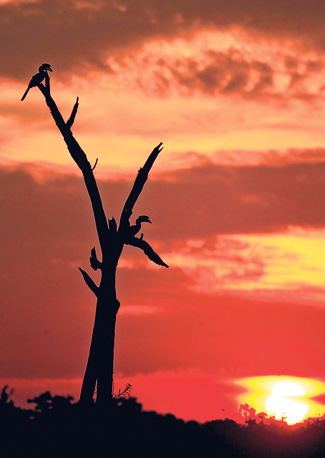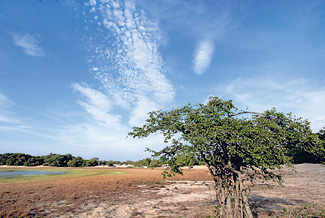Wilpattu National Park had reopened the previous Saturday - on February 27. I was on a day trip from Colombo on the invitation of Nigel Forbes who when the park was previously open, undertook regular day trips from Colombo. Also with Nigel was Ranil Pieris who seemed to remember every topographical feature and site name in the park.
We were just the eighth vehicle to enter the park that day. Dinushka Senanayake who is building a cottage close to the park entered the park later with her uncle, the famous artist Laki Senanayake. We had hired one of the local safari vehicles and the first thing which struck me was how low the horizontal roof bars were.
I had encountered the same problem in 2001 when I began commercial leopard safaris in Sri Lanka for the overseas market. It took two years to persuade safari vehicle operators to raise the roofs by at least another six to eight inches so that clients could view comfortably without having to hunch, to avoid the roof bars which were at eye level.
Wilpattu will also need the big leisure companies to insist on the modification of jeeps before something as obvious and basic as safari vehicles with roofs at the right viewing height become freely available.
Some of the sinks in the toilets at the ticket office, were already blocked, one week after the re-opening. This country should sub-contract the visitor facilities to the private sector as they do in Malaysia.
 |
| Malabar Pied Hornbills silhouetted against a flaming sky |
 |
| Villus aplenty |
One evening's game drive from around 3 p.m. till dusk is not enough to judge a park. However, as has been seen before when parks are closed and re-opened, the animals will need time to get used to vehicles. We saw just eight individual mammals of five species. There were just three individual Spotted Deer seen at three different water holes. They all ran out of sight. A mother sambhur and its calf were seen at dusk and they ran ahead along the grassy plains beside the road passing Kokkari Villu, the largest of the villus in the park. A Hanuman Langur ran across the road between the park office and the Mardanmaduwa.
On the way back on this road we saw a Black-naped Hare. The efforts of the previous warden Mr. Pushpandana to clear the invasive Nellu, were still apparent. The others saw a Mongoose which they thought could have been a Brown Mongoose. We did not see any Barking Deer which the park is famous for.
The bird life was very good. We did not spend much time in the monsoon forest of which the park has a lot, especially along the road from the park entrance to Maradanmaduwa, a distance of around 14 km. We observed a few forest birds when we stopped at a water hole at Ilande Mottai.
Our tracker Milinda had seen a leopard the day before and a group had reported a sighting at 12 noon. We observed a male of the resident race Asian Paradise-flycatcher bathing in the pool. A pair of Black-naped Monarchs chatted loudly. Calls of Ceylon Green-pigeons, Green Imperial Pigeons, Emerald Doves, Ceylon Woodshrikes and Common Ioras filled the air. Malabar Pied Hornbills were encountered thrice.
The villus, some of which are salty, were good for wading birds. The small and beautiful Kuda Patessa, fringed with white sand dunes had marshy edges. This held at least eight Pintail Snipe at close range. As I did not want to delay the others I did not maintain bird notes by villu. But the spread of waders seen amongst the villus included the following species;Wood, Green and Marsh Sandpiper, Greenshank, Black-tailed Godwit, Lesser Sand Plover, Golden Plover, Great Thick-knee, etc.
A Crested Hawk-eagle stayed unusually calm when the jeep pulled up underneath where it was perched. It was so close that it filled the frame of a 300mm lens. The crest of this individual showed very clearly. I pointed out that the name Changeable Hawk-eagle is now reserved for a related species which occurs from the Northern-eastern part of India whilst the name Crested Hawk-eagle is used once again for the bird found in Sri Lanka, which extends to Northern India.
Migrant birds included Blue-tailed Bee-eater, Brown Shrike, Barn Swallow, Indian Pitta, Whiskered Tern and the waders mentioned earlier.
A few species of Pierid butterflies (whites and yellows) in a few tens were patrolling the woodland rides. After the North-east monsoon, they can reach numbers of tens of thousands. The species present included Lesser Albatross and Dark Wanderer. The prominent and larger butterflies included Blue Mormon and several Crimson Roses.
The park, in a physical context remains beautiful and unspoilt despite the various tragic events that marked its recent history. It is also undoubtedly rich in a diversity of species and one game drive cannot even scratch at the surface of its bio-diversity richness.
The reasonably good roads, without heavy traffic means that Wilpattu is possible as a day trip from Colombo to those with stamina. It's a comfortable visit from the hotels in Anuradhapura. In the Sunday Times Plus of Sunday, March 7, I unveiled that Kalpitiya is the one of three whale watching hot spots in Sri Lanka. Whales in Kalpitiya, leopards in Wilpattu and birds in Mannar mean the north-west of Sri Lanka now has a significant centre of gravity for wildlife tourism.
Gehan de Silva Wijeyeratne is CEO of Jetwing Eco Holidays. These are lightly edited journal notes. Gehan is on www.jetwingeco.com, Facebook, Twitter and Flickr. |
